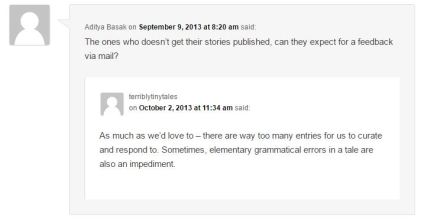Social Media has provided a global platform that people use to express themselves. It has also shaped the way information is disseminated throughout the world. Different platforms like Facebook and Twitter provide different ways to share information and communicate, and at times impose certain constraints on how people communicate with each other. Sometimes, these constraints drive creativity.
Twitter’s 140 character limit for example, helped popularize micro fiction 1. Today, communities like Terribly Tiny Tales and The Scribbled Stories have thousands of followers and contributors. Trying to convey as much information and emotion in as few words as possible has been around since a long time, of course. But the micro tales format, its acceptance and widespread popularity is symbolic of the social media phenomenon and how it affects us all.
The widespread success of these communities and these works of micro fiction got me thinking about its origins, its rise to popularity, and like any massively popular meme or internet trend, and why there are so many people who think it has “lost its touch”.
What is micro fiction, and who are these communities?
The origins of micro tales can of course be traced to Twitter, founded in 2006, a social media platform that allows users to share short posts (140 characters or less) called tweets. The aforementioned “Terribly Tiny Tales” started of as a Facebook page in 2013 2. The about page on their official website, terriblytinytales.com, says
“terribly tiny tales brings together a diverse pool of fantastic writers to create one tweet-sized story, everyday. We invite readers to contribute a word from which the writer picks a word of his/her choice.”
Another popular micro fiction community is “The Scribbled Stories”, which started off in 2015, and seems to have a similar format, but describe themselves as
“… a collective of amateur writers and serves as a storytelling platform for writers across the globe.”
As such, the latter does not seem to be limited to micro fiction as can be seen from their website, thescribbledstories.com. However, their most popular content seems to be in that format, most often shared as an image with white text on a blue background 3.
Why is Micro Fiction so popular?
1. Easy to Share
The character restriction lends itself to the creation of short tales, snippets or even poetry, often with complexity and nuances that force the reader to “read between the lines”. As these works of fiction are short by definition, they are often shared as an image rather than in text format, which makes them easy to share. The combination of being easy to consume and easy to share can often create a snowball effect of viral internet success.
2. Easy to write, and your work gets validated
Writing, and creative writing especially so, is often perceived as being the domain of the creative. It is looked upon as something that you need to have an innate knack for. Terribly tiny tales started with a group of 15 writers, but it has since then been opened to the public. The Scribbled Stories also has a similar system, people can submit their creations via the submit page on their website. They even mention various categories based on word limits.
Once you submit your work, it’s looked at by a team, and shared on social media if it’s accepted. This is the modern equivalent of writing to a newspaper, a radio show, or your school magazine. The convenience of being able to submit your work online, and the validation of your post being read and accepted by someone and shared on social media for thousands of people to see is the ultimate reward in today’s world. The relative ease of writing something in the micro fiction format, combined with the anticipation, waiting to see whether or not your post will be selected, and the reward of having your post shared with thousands of people, and indeed even being “liked” and “shared” by people is a massive validation of a person’s writing capability.
3. In tune with our short attention spans on social media
This post by Mark Manson explains this very well. In the world of social media our attention is at a premium- and anything that grabs your attention is shared, and in most cases, forgotten about soon after. Micro Fiction communities generate so much content that spans across so many different topics, that any given piece of content has a chance of resonating with a certain section of the general populace.
Most people, when asked about why they share certain things, often reply with “I don’t know, it just felt nice at the time…”
If it’s so popular, why do some people hate it?
When something resonates with people, as is the case with internet memes and viral trends, there’s always a saturation point, where the interest begins to wane, or even turn into a dislike due to it being repeated many times. In this post I’ve mentioned only the two most popular platforms for micro fiction, but in reality there are a lot of such pages out there, and while Terribly Tiny Tales does touch upon the problem of curating so many entries 4, there are so many other spin-off communities around which perhaps look only for viral success via post volume, rather than post quality.
I think that this lack of curation is one of the key reasons why some people are annoyed. With so many people getting to post their micro fiction and get published, with little to no curation, these communities become less about getting your work accepted, appreciated and understood, but more about being cannon fodder that feeds the social media machine. This might sound cynical but it does seem like the move away from a small group to an open community with no moderation, no community feedback mechanism and no centralized curation is a deliberate move to gain followers, gain likes, shares, and perpetuate the aforementioned social media machine.
What do the owners of these pages stand to gain from this perpetual social media juggernaut? When you have a massive social media influence, it can be used to make money, and brands have already begun to utilize these communities as a platform to gain some traction.

This image shows how blatant the brand tie-ins can be at times.
Objectively analyzing micro fiction
What constitutes good micro fiction is highly subjective. What some people might find appealing in a cute, smart or funny way, might not be looked at the same way by others. Personally, I feel like good micro fiction should have multiple layers of meaning, requiring you to “read between the lines”.
However, looking at a lot of these works, I find that many of these “stories” have simple, linear narratives. They are often simple anecdotes which while a lot of people can relate to, aren’t really very complex. A lot of these are based on common events and are thus regarded as unoriginal. When a lot of seemingly trite content floods social media feeds, it leads to an inevitable negative reaction 5. Anecdotes are easier to write, as they are based on real life events. They are easy to read because of their linear narrative. They are easy to relate to because most of these anecdotes are based on very common events that occur in most people’s lives, such as getting bad grades in an exam, for example.
This brings us back to the broader issue of categorization and curation. The micro fiction communities have broadened their scope, and their definition of what they consider “tiny tales” or “stories”, for the reasons mentioned previously.
What can they do to improve?
I feel like the key component missing in this whole micro fiction “community”, is the lack of any feedback. There is no community moderation. A sign of a healthy community is discussion, and constructive criticism, which I find completely lacking in any of these Facebook pages. People are expected to submit their work, and hope that it is published. There is no feedback from the people who run the pages, and there is no way to garner feedback from the other members of the community 6.
One of the ways to provide constructive feedback is to connect these prospective writers with established ones. Of course, this seems like an idealistic solution, but I do believe that social media is an extremely powerful tool that can make this happen. If a community focuses on the core group of people that actively want to improve, and aren’t just there to feed off its popularity for personal gain, I believe that it could be a great tool for people who want to be better.
A few points in conclusion:
- The topic of micro fiction and it’s popularity is full of nuances that I wish to capture, and I’ve just scratched the surface. I would love to have a hear from others about their opinions and experiences, so I can see things from all possible points of view.
- I would love to be able to know how these pages/communities are run to get a better understanding or appreciation of the challenges involved in bridging the gap between the current and ideal state of the community.
- Feel free to criticize, but keep it civil. I may even create another post where I respond to your comments.
- While criticizing, poking fun at or even hating these micro fiction communities is fine as a personal choice, having a “holier than thou” attitude is not. What I do not like, are people who try to act like the gatekeepers of “good writing”, which may demotivate people. Say what you will about micro fiction, but I like to think that there are at least some people there who want some positive affirmation, some validation of their creativity, people who just need someone to provide feedback and maybe even guidance. Don’t be like this guy.
- It would be great to look at Micro Fiction in the backdrop of our social media culture as a whole and how it can be used to explain our behavior on social media.
- Shout out to @thewisecrab and @twatterbaba on Twitter who listened to my ideas and provided feedback.
Footnotes:
A few good examples of micro fiction on twitter are Instant Fiction and @ThePatanoiac
- This Quora post talks about the origin story, and it is as follows:
“Terribly Tiny Tales started off as a Facebook page back in 2013, conceptualized by Anuj Gosalia, and later joined in by Chintan Ruparel. The platform consisted of a team of 15 writers who contributed regularly. 3 years later, we are a community of approximately 100 writers who work closely with us as well as over 50,000 writers who share their work with us from all over the world.”
Anuj Gosalia also has a Twitter page in which he describes himself as the “Co-Founder/CEO – Terribly Tiny Tales”, which gives credence to the above.
- As such, Terribly Tiny Tales also seem to have a distinct style of white text on a black background, but they have often deviated from that style for collaborations with various websites or for particular topics. This can be seen on their website under collaborations.
- On the topic of curation, Terribly Tiny Tales had this to say, to one of the commenters on their website:

- In fact, there are a lot of people who openly poke fun at this trend. One example is Stand-up comedian Sahil Shah who often shares “terribly tatti tales”, like this one.
- Perhaps getting feedback from others does not make too much sense in the case of micro fiction, as the amount of words used are too less, and it is not too easy to critique something that is meant to be interpreted in multiple ways. But I am open to more suggestions!

